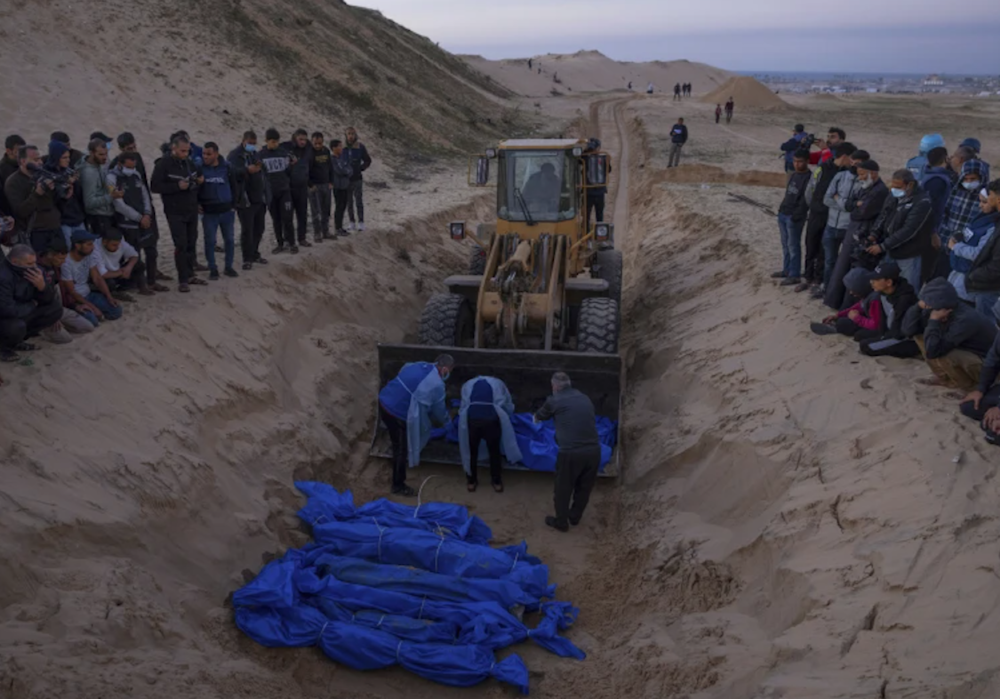AP investigation concludes 'entire families decimated' in Gaza
Between October 7 and December 24, AP geolocated and evaluated ten Israeli attacks, including some of the bloodiest, resulting in the death of almost 500 Palestinians.
-

A bulldozer unloads the bodies of Palestinians killed in Israeli strikes during a mass funeral in Rafah on December 26, 2023. (AP)
The Israeli war on Gaza is murdering entire Palestinian families in unprecedented numbers.
Entire lineages, often four generations of the same family, have been killed in single or many attacks on members of the same family who were sheltering from the bombs.
An Associated Press investigation identified at least 60 Palestinian households in which 25 or more individuals were murdered in bombings between October and December in what was called the bloodiest and most damaging chapter of the war, which is currently in its ninth month.
Key findings from the analysis indicate that several families have nearly no one left to register the toll, and thousands are unable to account for all of their relatives due to the huge numbers still under the debris.
The AP's probe included records published by Gaza's Health Ministry until March, online death notices, family and neighborhood social media sites and spreadsheets, witness and survivor narratives, and statistics from Airwars, a London-based conflict monitor.
Between October 7 and December 24, AP geolocated and analyzed ten Israeli attacks, among the bloodiest in the ongoing genocide, resulting in the death of almost 500 Palestinians.
The Mughrabi family was among the families mostly affected, with around 70 people slain in a single Israeli airstrike in December. Meanwhile, more than 50 of the Abu Najas family were murdered in attacks in October, including at least 2 pregnant mothers.
The vast Doghmush tribe lost at least 44 members in a mosque attack, and the figure increased to over 100 weeks later; by spring, more than 80 members of the Abu al-Qumssan family had been slain.
The ten strikes investigated by AP mainly hit residential buildings, homes, and shelters where parents, children, and grandparents sought refuge and safety. There was no evident military target or a clear warning to the people inside. The Salem family lost at least 270 members in all.
At one point, they flew a white flag above their building, refusing to evacuate since no place was safe.
More than 170 family members were slain in two explosions eight days apart. Three attacks over four weeks killed 30 al-Agha members, while a series of strikes in a refugee camp in December killed 106 individuals from at least four families.
In one raid on the crowded Jabalia refugee camp in northern Gaza, Israeli bombs destroyed an entire block of structures, killing almost 40 members of the Abu al-Qumssan family.
The murdering of families spanning generations is a crucial aspect of the argument for the International Court of Justice's case against "Israel".
Craig Jones, a Newcastle University lecturer who researched the function of "Israel's" military attorneys, stated that the occupation has reduced its standards for civilian casualties, fuelled by fury.
The law of war permits a "sort of rushed form of warfare" with increased civilian losses in which a force must respond rapidly and under changing conditions, yet "Israel is just so clearly violating the law because it's pushing the rules so far," he stated.
Everyone in my family was either killed or injured: Nuseirat massacre
The shock and grief have suffocated the streets of the Nuseirat refugee camp after 274 Palestinians of all ages, yet mainly children, were massacred in cold blood last week, as per Gaza's Health Ministry.
The harrowing images emerging from the recent massacre have reverberated across the globe, igniting a wave of widespread protests and demonstrations. From bustling city streets in Chicago to remote villages in Pakistan, people everywhere are united in their condemnation of the Israeli atrocities witnessed in Gaza.
Two eyewitnesses, Asia al-Nemer, searching for a pharmacy with remaining stock of her sister's medication, and Ansam Haroun, aiming to purchase new clothes for her daughters to lift their spirits ahead of the Eid al-Adha holiday, recounted the horrors of the Israeli massacre, The Guardian reported.
Earlier in the year, this area of central Gaza had become deserted when Israeli troops passed through, demolishing Haroun's home in an airstrike. However, the area experienced since May a surge in population as over a million people were forcibly displaced northward to escape another Israeli aggression on the Nuseirat refugee camp.
"The Nuseirat market is always crowded, but now more than usual because of the many displaced people," said Haroun, 29, who is currently residing with an uncle.
She recounted, as cited by The Guardian, that she was browsing outfits for her daughters when the initial Israeli airstrikes commenced. Almost instinctively, she dashed out of the door to reach them.
Outside, she encountered a scene reminiscent of "the horrors of judgment day" with panicked crowds attempting to flee the impending onslaught. Soon, helicopters and quadcopter drones would join the assault, resulting in hundreds of casualties and bodies strewn across the streets, as depicted in images from the area.
“Everyone was screaming, terrified,” she said, as quoted by The Guardian.
“The street I was on was only 50 meters long, but it was packed with hundreds of people, all running. A woman next to me fainted from terror, and I saw vendors abandoning their goods on the roadside to flee,” she stressed.
El-Nemer, a 37-year-old software engineer originally from the northern part of Gaza, was also among the crowd of people witnessing the Israeli carnage.
“I was jogging along the street with other women. We were terrified,” she said.
They hurried past health clinics and schools, places where they might have sought refuge in the past but now avoided due to deliberate Israeli attacks on such facilities.

 6 Min Read
6 Min Read








